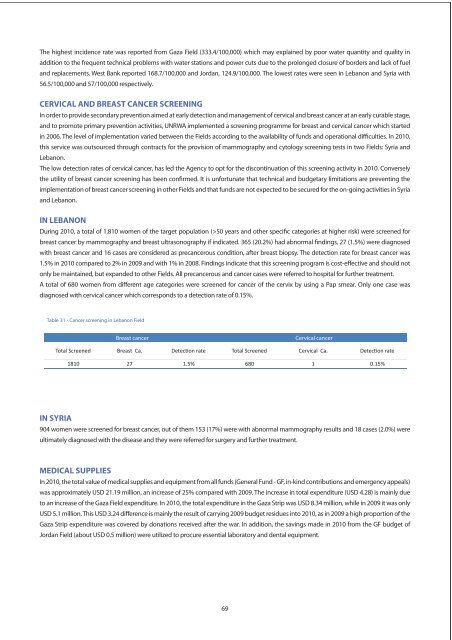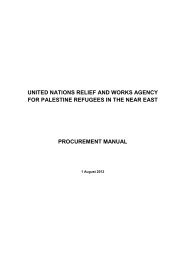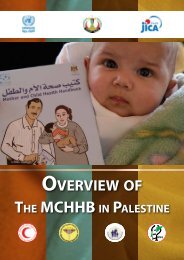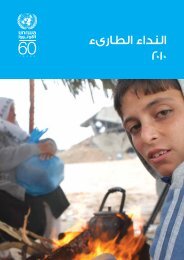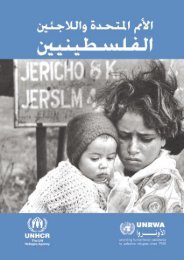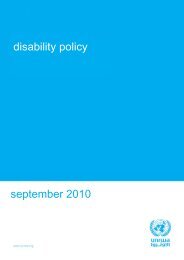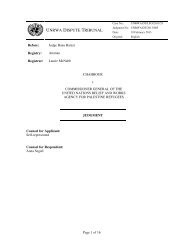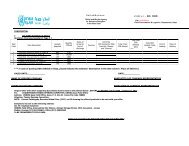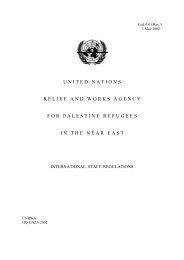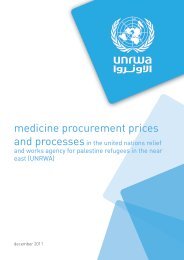Annual Report of the Department of Health 2010 - Unrwa
Annual Report of the Department of Health 2010 - Unrwa
Annual Report of the Department of Health 2010 - Unrwa
You also want an ePaper? Increase the reach of your titles
YUMPU automatically turns print PDFs into web optimized ePapers that Google loves.
The highest incidence rate was reported from Gaza Field (333.4/100,000) which may explained by poor water quantity and quality in<br />
addition to <strong>the</strong> frequent technical problems with water stations and power cuts due to <strong>the</strong> prolonged closure <strong>of</strong> borders and lack <strong>of</strong> fuel<br />
and replacements. West Bank reported 168.7/100,000 and Jordan, 124.9/100,000. The lowest rates were seen in Lebanon and Syria with<br />
56.5/100,000 and 57/100,000 respectively.<br />
CERVICAL AND BREAST CANCER SCREENING<br />
In order to provide secondary prevention aimed at early detection and management <strong>of</strong> cervical and breast cancer at an early curable stage,<br />
and to promote primary prevention activities, UNRWA implemented a screening programme for breast and cervical cancer which started<br />
in 2006. The level <strong>of</strong> implementation varied between <strong>the</strong> Fields according to <strong>the</strong> availability <strong>of</strong> funds and operational difficulties. In <strong>2010</strong>,<br />
this service was outsourced through contracts for <strong>the</strong> provision <strong>of</strong> mammography and cytology screening tests in two Fields: Syria and<br />
Lebanon.<br />
The low detection rates <strong>of</strong> cervical cancer, has led <strong>the</strong> Agency to opt for <strong>the</strong> discontinuation <strong>of</strong> this screening activity in <strong>2010</strong>. Conversely<br />
<strong>the</strong> utility <strong>of</strong> breast cancer screening has been confirmed. It is unfortunate that technical and budgetary limitations are preventing <strong>the</strong><br />
implementation <strong>of</strong> breast cancer screening in o<strong>the</strong>r Fields and that funds are not expected to be secured for <strong>the</strong> on-going activities in Syria<br />
and Lebanon.<br />
IN LEBANON<br />
During <strong>2010</strong>, a total <strong>of</strong> 1,810 women <strong>of</strong> <strong>the</strong> target population (>50 years and o<strong>the</strong>r specific categories at higher risk) were screened for<br />
breast cancer by mammography and breast ultrasonography if indicated. 365 (20.2%) had abnormal findings, 27 (1.5%) were diagnosed<br />
with breast cancer and 16 cases are considered as precancerous condition, after breast biopsy. The detection rate for breast cancer was<br />
1.5% in <strong>2010</strong> compared to 2% in 2009 and with 1% in 2008. Findings indicate that this screening program is cost-effective and should not<br />
only be maintained, but expanded to o<strong>the</strong>r Fields. All precancerous and cancer cases were referred to hospital for fur<strong>the</strong>r treatment.<br />
A total <strong>of</strong> 680 women from different age categories were screened for cancer <strong>of</strong> <strong>the</strong> cervix by using a Pap smear. Only one case was<br />
diagnosed with cervical cancer which corresponds to a detection rate <strong>of</strong> 0.15%.<br />
Table 31 - Cancer screening in Lebanon Field<br />
Breast cancer<br />
Cervical cancer<br />
Total Screened Breast Ca. Detec on rate Total Screened Cervical Ca. Detec on rate<br />
1810 27 1.5% 680 1 0.15%<br />
IN SYRIA<br />
904 women were screened for breast cancer, out <strong>of</strong> <strong>the</strong>m 153 (17%) were with abnormal mammography results and 18 cases (2.0%) were<br />
ultimately diagnosed with <strong>the</strong> disease and <strong>the</strong>y were referred for surgery and fur<strong>the</strong>r treatment.<br />
MEDICAL SUPPLIES<br />
In <strong>2010</strong>, <strong>the</strong> total value <strong>of</strong> medical supplies and equipment from all funds (General Fund - GF, in-kind contributions and emergency appeals)<br />
was approximately USD 21.19 million, an increase <strong>of</strong> 25% compared with 2009. The increase in total expenditure (USD 4.28) is mainly due<br />
to an increase <strong>of</strong> <strong>the</strong> Gaza Field expenditure. In <strong>2010</strong>, <strong>the</strong> total expenditure in <strong>the</strong> Gaza Strip was USD 8.34 million, while in 2009 it was only<br />
USD 5.1 million. This USD 3.24 difference is mainly <strong>the</strong> result <strong>of</strong> carrying 2009 budget residues into <strong>2010</strong>, as in 2009 a high proportion <strong>of</strong> <strong>the</strong><br />
Gaza Strip expenditure was covered by donations received after <strong>the</strong> war. In addition, <strong>the</strong> savings made in <strong>2010</strong> from <strong>the</strong> GF budget <strong>of</strong><br />
Jordan Field (about USD 0.5 million) were utilized to procure essential laboratory and dental equipment.<br />
69


